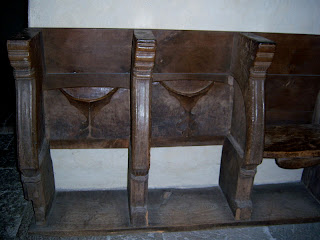The Vreta Kloster, Abbey at Linkoping where the old kings are buried, is really in Berg. King Inge, who (according to an undated letter in 1100, the year he also died) founded the monastery with Queen Helena, see ://www.vretaklosterforening.se/Jub/En/historia.html/ With the Reformation in 1527, the Abbey was isolated, and ceased to be a Catholic place when the last nuns died by 1582. Old buildings went to ruin, but were unearthed in the early 20th Century, followed by restorations in 2002-2007.
Try to find the burial place of kings, in pre-Christian polytheist era, and the guidebooks will point you to Linkoping. Get to Linkoping and where is it? It is not here. Go to a nice air military and cultural museum instead, mostly WWII, enjoy, and try again for the old kings.
Get lost and follow a sudden bus route toward Linkoping proper again, and find Vreta Kloster instead in the town of Berg. This is one of the oldest monastery sites: Benedictine, and then Cistercian, or the other way around; dating from 1100 AD. Guidebook people: include a short GPS address with your sites. Every hour counts in the later afternoon. If all is locked up, because the official summer season hours expired yesterday, knock at the rectory.
Then, enjoy. Enjoy the official caretaker, from his house. He was at home when we knocked, and really seemed pleased to show us and unlock the whole thing. Thank you, thank you. Do remember to compensate. I hope we did enough.
There are royal family details still here: a son of a king with behavioral problems, could worship in his own pew. Checking our notes to see which monarch's son was here, out of the way, under the steps at the front, to the side.
What is the funnel, on top right back, of this old chest? Was this a "poor box" with a place for coins?
Very old wood carving, looks like madonna and child, probably, Vreta Kloster, Berg. The more primitive the carving, the more moving. Is that so? Who stole the religion of Everyman and made it for the exclusionist fancies instead?
Another carving, Vreta Kloster.
The paint is still bright on this very old carving of a saint, perhaps an apostle in the Vreta Church.
Whose coat of arms is this? Need to zoom and research. To the bottom, the old chandelier. To the right, the new silver. Prefer the old.
Always aim for choir stalls. There, the people had to rest their bottoms during the long services. Bum-proppers here as well. Flip them up, as though you are standing at attention, but you are really relaxing back. Ahhhh.
Now to the burial areas:
Vaults octagonal, ironwork, copper coffins, marble urns. The 1663 burial place of the Douglas Family. A recently deceased member of the Douglas family, Countess Margareta C.H. Douglas, who died in the United States, will be interred here. See ://www.legacy.com/obituaries/dailyprogress/obituary.aspx?n=margareta-douglas&pid=142179776/ Still trying to find out how a "Douglas" came to Sweden. Long ago, apparently. Here it is: Wikipedia says he Count of Skenninge, was a Scots, and a field marshal in the Swedish Army during the 30 Years' War, and Swedish-Polish wars. See http://en.wikipedia.org/wiki/Robert_Douglas,_Count_of_Skenninge/ He had been elevated to Baron, and Lord of the Horse. What? For the British view of that, see ://www.royal.gov.uk/TheRoyalHousehold/OfficialRoyalposts/MasteroftheHorse.aspx/
This appears to be part of the Douglas Family vault, and there are references elsewhere to the many crests located there. What is striking: how effective painted wood carvings are. More so than plain stone we saw in more southern areas. Breathtaking, and we don't say that lightly. And unfaded.
There is nothing "folk" about wood carving in Sweden. Still looking up whose crest this is.
We always like doors. Here, broad and squat. But look at the reinforcement at top and bottom for the slats, the iron bolts securing other-side reinforcements, and the huge lock. Then, the very plain surface otherwise.
Then there is more of the kind of simplicity seen in the door. Here, a simple chapel, and a baptismal font. One huge stone, decorated, on a pedestal.
This would have been used later, as we understand that baptisms at the early times occurred outside, in outside immersion areas. Is that so?
With the most medieval parts off to the side, as burials (see Kings, another post) the main sanctuary has been restored to its more renaissance style. We like the more primitive.
 Vreta Kloster, Vreta Abbey Church, Berg, Sweden. Exterior
Vreta Kloster, Vreta Abbey Church, Berg, Sweden. Exterior Side-lined special pew, Vreta Kloster, for son of monarch, and who had rage disability, or perhaps epilepsy, so he could atttend services.
Side-lined special pew, Vreta Kloster, for son of monarch, and who had rage disability, or perhaps epilepsy, so he could atttend services. Poor box, perhaps, Vreta Kloster, Berg, near Linkoping, Sweden
Poor box, perhaps, Vreta Kloster, Berg, near Linkoping, Sweden Madonna and Child, Sancta Maria de Vretis perhaps, Carving, Vreta Kloster, Berg, Sweden. May be 11th-12th Centuries
Madonna and Child, Sancta Maria de Vretis perhaps, Carving, Vreta Kloster, Berg, Sweden. May be 11th-12th Centuries Saint, perhaps Apostle, Carving, Vreta Abbey, Vreta Kloster, Sweden
Saint, perhaps Apostle, Carving, Vreta Abbey, Vreta Kloster, Sweden Frescoes, walls, Vreta Kloster
Frescoes, walls, Vreta Kloster Choir stall bum-proppers, Vreta Kloster, Berg, Sweden
Choir stall bum-proppers, Vreta Kloster, Berg, Sweden Vreta Abbey, Vreta Kloster, Berg, Sweden. Burial chapel for the Douglas Family
Vreta Abbey, Vreta Kloster, Berg, Sweden. Burial chapel for the Douglas Family Family crests, Burial vaults for Douglas still?
Family crests, Burial vaults for Douglas still?  Wood-carved family crest, painted; Vreta Kloster, near Linkoping, Sweden
Wood-carved family crest, painted; Vreta Kloster, near Linkoping, Sweden Bolted door, Vreta Monastery, near Linkoping, Sweden (Vreta Kloster)
Bolted door, Vreta Monastery, near Linkoping, Sweden (Vreta Kloster) Baptismal font, Vreta Kloster, Linkoping (Berg) Sweden
Baptismal font, Vreta Kloster, Linkoping (Berg) Sweden Pulpit, 1600's, and view, Vreta Kloster, Berg, Sweden (Linkoping)
Pulpit, 1600's, and view, Vreta Kloster, Berg, Sweden (Linkoping)
No comments:
Post a Comment